IPM 7 Fighting Varroa -The Arsenal: “Natural” Treatments – Part 1
IPM 7 Fighting Varroa 7
The Arsenal:
“Natural” Treatments
Part 1
Randy Oliver
ScientificBeekeeping.com
First Published in ABJ in August 2007
(Ninth in a series on integrated pest management of Varroa)
Disclaimer: I am not licensed to make any pesticide recommendation. I am merely reporting on information from appropriate authorities. You should consult your local authority for recommendations.
Update: please note that there are numerous updates on these methods in subsequent articles on this website.
What are “natural” treatments?
In the last two articles in this series I detailed the pros and cons of the synthetic miticides that are currently the mainstay of the U.S. bee industry. However, there are also a number of alternative miticides of “natural” origin that have been used for years in Europe. A few have already been, or are about to be, registered for use in the United States. Beekeepers may wish to use the natural miticides for various reasons: as an alternative to, or in rotation with, synthetic miticides that are failing due to varroa resistance; to give the colonies a break from chemical sublethal effects or comb contamination; to avoid miticide toxicity to drones and queens; to meet “organic” production standards (when allowed); or due to personal preferences or concern about chemical residues in honey.
The natural treatments currently consist of organic acids and essential oils. These chemicals (yes, they are indeed chemicals) have often been referred to as “soft chemicals.” So, why am I using the term “natural treatments” instead of “soft chemicals”? In the first place, there’s nothing “soft” about either the acids or the oils—they decimate the mite, and can kill your bees if over dosed. They are poisons, pure and simple—developed by plants (and in the case of formic acid, also ants) to kill, repel, or deter other organisms. The key word is that they are “natural” poisons, and there are certain advantages to that qualifier. The primary selling point is that these types of natural poisons are what gives spices “spice,” herbs their aroma, and fruits and vegetables their tartness. In other words, our bodies are used to eating them, can handle them safely at low levels, and perhaps most importantly, they are fairly warm and fuzzy in the honey-buying public’s perception.
I propose that we use the term “natural” to refer to any miticide that is naturally found within a beehive. The beauty of this is that we’re not adding anything that wasn’t already there (in some small amount). Plus, the bees already know how to detoxify them in their own bodies, and they aren’t likely to be considered as contaminants of honey. These are generally “food grade” chemicals that the honey consumer isn’t going to freak out about, and that aren’t likely to affect your own health negatively. And doesn’t the term “natural treatments” have a nicer consumer ring to it than “soft chemicals” or “biopesticides”?
The physician/alchemist Paracelsus admonished that poisoning is a consequence of quantity, not substance. In the case of the natural treatments, we simply jack up the “quantity” to a high enough concentration to kill the mite, but not quite high enough to kill the bees. This is a bit trickier with natural treatments than with the synthetic acaricides. In the case of fluvalinate (Apistan), for instance, bees don’t die until you reach a dose 800–1000 times higher than it takes to kill mites. With the natural treatments, the margin of safety may be more on the scale of 2–4 times! In other words, the dose is much more critical—a little low, and you don’t get good mite kill; a little high and you kill brood, or the bees start dropping. In the words of Medhat Nasr, these are dumb chemicals for smart beekeepers. You’re really going to have to follow label directions with these bad boys!
It’s been frequently asserted that the natural miticides will be “sustainable,” that is, that the mite is unlikely to develop resistance to them. I don’t buy this. Milani (2001) speaks for biologists when he states: “There is no reason to believe that the varroa mite cannot develop resistance against acaricides of natural origin or simple molecules (e.g., formic acid). There are hundreds of species of insects and mites which feed on plants containing natural toxins.” Even though formic acid has been used for some 30 years in Europe with no apparent sign of resistance, with continued regular use without rotation, the tolerance of the mite to formic would likely approach the tolerance level of the bee. In other words, you’d kill your colony before you killed enough mites to make it worthwhile. My point is, it would be unwise to use any single natural treatment as a Silver Bullet.
Safety
If you’re concerned about chemical safety, stick with powdered sugar dusting and drone trap frames. I’d have a hard time making the case that the natural treatments are safer to handle than the registered synthetic acaricides. I did a little math. It would take about 24 Apistan strips (fluvalinate) to kill an average man (by ingestion), but less than 1 Checkmite+ strip (coumaphos). It would take nearly 5 scoops of Apiguard (thymol), or half a pad of MiteAwayII (formic acid). Clearly, most beekeepers aren’t tempted to munch on miticides, but the natural ingredients aren’t overwhelmingly less toxic. There are two likely means of exposure: by handling the product or breathing the fumes. Neither Apistan nor Checkmite evaporate much, so fumes are not an issue. Apistan was astoundingly safe to handle, Checkmite not quite so. Both MiteAway and Apiguard can burn unprotected skin, or cause eye or lung damage. Or how about that attractive bottle of wintergreen oil that smells like root beer? Two teaspoons is the average lethal dose for a child! Concerning oxalic acid, I detailed the safety issues in a previous article.
So what’s my point? Folks, we’re talking about poisons, whether synthetic or natural. Use them judiciously, and follow label directions carefully. More is not better, and off label uses are not the same as the registered formulations. However, I do see some safety advantages to the natural treatments. First, the human body has dealt with them in our food for as long as humans have existed, and we can detoxify moderate quantities. Secondly, they are not “insidious” chemicals. You know if you’re breathing formic or thymol vapors, or if your skin is burning from oxalic acid. Your natural instinct is to stop breathing, or to wash off the burning substance. The damage generally ends at that point—you’re not going to find out ten years later that some synthetic chemical has been secretly hanging out in your body fat or destroying your nerves. Be smart, be safe, and use chemicals minimally.
Legality of use
The natural treatments are variously registered in different countries. In the U.S., there are two registered formulations of thymol, one of formic acid pads, oxalic acid is in the process, and the other essential oils are in a “gray area” state to state. Consult the state apiculturalist for legality in any state in which you apply them.
Efficacy
The Silver Bullets fluvalinate and coumaphos spoiled us as far as degree of efficacy at killing varroa with a single (extended) treatment. When the mite was first introduced to these chemicals, we could expect kills better than 98% (however, as detailed previously, those rates didn’t hold for long).
So how do the natural treatments fare? Efficacy may be as low as 65%, dependent upon the number of treatments, temperature, number of brood chambers, hive ventilation, and amount of brood present. However, when properly applied (following label directions to the “T”), thymol, formic acid, or oxalic can all result in mite kills exceeding 95%!
One of the advantages of the natural treatments that act as fumigants (formic acid, thymol, other essential oils) is that they have a shorter treatment period (3 weeks) compared to the synthetic miticides (about 6 weeks) (Calderone 2006).
Organic acids
The Achilles’ heel of varroa appears to be acids. Nature provides us with an abundance of organic acids to play with. Some that have been tested with varroa are acetic, citric, lactic, oxalic, and formic. The common food acids–acetic acid (vinegar), citric acid (lemons), and lactic acid (which makes yogurt and sauerkraut sour) are not “strong” (don’t dissociate) enough to be effective. Even heat vaporized acetic acid has been found to be ineffective. That leaves oxalic and formic acids, with the huge difference between the two that oxalic remains a solid (or in solution) at hive temperature, whereas formic vaporizes rapidly.
Oxalic acid
I’ve covered oxalic acid pretty well previously, and updates are available at www.randyoliver.com (on p. 5 of the oxalic article). The most important updates are suggestions to make the syrup with deionized water, to use 8-mil nitrile mechanics’ gloves, and to not over apply if using a garden sprayer (use a syringe instead). Feedback on oxalic has been positive, provided that it was not over applied. Locally, a beekeeper had to wait until Christmas to apply it this past winter, due to warm weather that allowed late broodrearing, but was very happy with the results! He took healthy, essentially mite free bees to almonds.
Formic Acid
Unlike the synthetic miticides, whose modes of action are well determined, that of formic acid on varroa is less understood, although it apparently affects a metabolic pathway, resulting in tissue suffocation (Keyhani 1980) or respiratory inhibition (Imdorf, et al 1999). Formic acid is the simplest organic acid, and due to its small molecular size, readily evaporates at room temperature. Once in vapor form, it can be used as a fumigant within the hive to kill varroa. Easily said, but as usual, the devil is in the details. Formic fumigation comes with a variety of issues—allow me to list some pros and cons:
Pros
1. Formic acid is a natural component of foods, and especially in ants, which some animals appear to eat for the “flavor.” Some birds place ants between their feathers–apparently to dislodge lice.
2. Formic vapors dissipate throughout the hive, killing phoretic varroa mites (but few in capped cells), plus tracheal mites within the bees’ bodies.
Update: formic acid at high enough concentration can kill nearly all the mites in capped cells. When I uncap cells after treatment, I find half to nearly 100% of the mites dead, depending upon the dose. In order to achieve high in-cell mite mortality, you need to apply formic at a rate that may cause the mortality of some queens. This may be mitigated by using an extended-release application (MAQS, MiteGone, Nassenheider, Ziplock bag with holes).
As pointed out by the manufacture of MAQS, even the killing of only the delicate male mites may result in unfertilized females emerging, unable to reproduce. You wouldn’t notice the results of this effect for some weeks.
The tracheal mite kill is a big plus if you are wintering bees in cold climates–it may make the difference between live and dead colonies come springtime.
3. Formic is a natural constituent of honey, and proper application does not raise residues to an extent that the EPA is concerned (EPA 2005).
4. Formic does not contaminate the combs in the long term.
Cons
1. Formic vapor (which smells similar to vinegar) is a corrosive irritant that can be toxic to the applicator, and to adult bees and brood at high concentrations. This safety issue is without a doubt the biggest concern.
2. Formic vapors can corrode queen excluders, mite screens, and nails.
3. Effective formic treatment requires an extended fumigation at appropriate vapor levels (not too high nor too low). Since formic evaporates quickly, and since vaporization is very temperature dependent, this presents challenges. There is a relatively narrow temperature range within which formic fumigation is efficacious.
4. Underdosing gives poor varroa control. Overdosing may result in brood or colony mortality or absconding.
5. Honey supers placed immediately after spring treatment do indeed contain elevated levels of formic acid at harvest, but generally not enough to taste (Donders 2005). Allowing supers to outgas before extraction helps to reduce levels.
6. Formic acid is tough on drones, may initially be tough on brood, and is not appropriate for weak colonies.
So how does one use formic acid? Believe me, beekeepers in various countries have tried myriad methods! Most of these involve diluting concentrated formic acid to a 65% solution, and then using various simple to complex methods or devices to control its release into the hive. I could go on for pages, but I’m not going to, for several reasons. First, it’s illegal in the U.S. Second, I cannot in good conscience recommend that anyone handle liquid formic acid in other than a laboratory or controlled industrial situation.
In my humble opinion, field use of liquid formic involves too much risk. Commercial bee work involves inherent dangers. I work with nail guns, knives, and hot wax, and have had my share of nails into my flesh, cuts, and burns. These wounds generally heal without serious aftereffects. A mishap with formic, however, can leave you blind, with seared lungs, or scarred flesh. You can be careful handling it once, or a hundred times, but eventually you or an employee are going to make a mistake!
Update: we now regularly use liquid formic acid (we have a 55-gal drum of 95% on hand). Murphy’s Law is in full effect when handling liquid formic. I’ve now met two different commercial beekeepers who have accidentally put their entire foot into 5-gallon buckets of liquid formic, and were forced to tear off their boots and socks to save their skin! Every splash of formic acid aims for your eyes. Never let your guard down, protect your eyes (a full face shield is best), and keep a garden hose at hand in case you need to rapidly wash off a spill. In the field, carry a gallon of water with dissolved baking soda to neutralize any spills.
I understand that there are those of you who are still going to want to handle the liquid. I have bee buddies who use it regularly, and it’s a common treatment in Canada and Europe. Therefore, I’ve included some references at the end of this article for your perusal.
Luckily for us, there is a user-friendly formic acid product registered for use in the U.S. MiteAwayII® is a cleverly packaged cotton pad containing a formate ester, rather than the acid itself. Update: this product has been replaced by MAQS and Formic Pro pads. But we still like to use the old MAII pads with a rim. The acid forms when the pad absorbs water vapor from the colony, thus effecting a sustained slow release of formic vapors. The pads come in a plastic bucket, individually sealed again in plastic. To use them, you cut open and discard the plastic outer wrap (this is the most time-consuming step), and place the pad, perforated side down, on spacers on top of the frame top bars in the upper brood chamber. You must then use an inch and a half wooden rim (see references) to space the hive cover up off the pad for air circulation. Three weeks later, remove the spent pad and rim, and you’re done! The treatment can be used right up to the day that you put honey supers on. (I hate to sound like a salesman for the product, but it really is clever!)
The 1½” spacer rim is an issue for large operators, who don’t want to make or store one more piece of equipment. Precut rims are inexpensive to purchase, or can be cut from old boxes (although I can’t say it’s necessarily worth the hassle). Having the spacers attached to the rim is handy.
Although I’ve described MiteAwayII in glowing terms, it still suffers from several of the generic formic acid “cons” listed above.
Safety
You’re still dealing with formic acid, so you need to wear gloves (8 mil nitrile mechanic’s gloves work great) and a respirator. The directions also call for wearing glasses and coveralls (washed daily), even when reentering the beeyard, and are just a wee bit extreme in my view (I doubt that the regulators ever actually worked with the product). I was surprised that Canadian registration doesn’t call for a respirator. David VanderDussen, the very personable CEO for MiteAway, explained that in Canada, regulators assumed that the product would be applied out of doors, whereas in the U.S. vapor levels were determined assuming an enclosed setting (like a greenhouse or wintering cellar). So the Canadians keep their hives outdoors and simply stay upwind, duh!
So just how irritating are the fumes? The vapors can make your eyes sting, skin tingle, and your nose and throat burn. Luckily, formic inhalation is “self regulating,” that is, the smell is noticeable before it reaches harmful levels, and if you do start to breathe strong vapors in, you immediately choke up and cough, and look for fresh air! In my limited experience, you’d definitely want to wear the respirator if you were opening a bucket close upwind or in an enclosed area, but it is easy to avoid the fumes if you are outdoors with any kind of air movement.
Disposable half-face respirators with “organic vapor” cartridges cost about $18. They come in three sizes—make sure that you get one that fits properly. You can test the fit by covering the cartridges with your palms, then inhaling. If it’s a good fit, the respirator will suck tight against your face. Store the respirator between uses in a zipper plastic bag, inside an airtight food storage container. You’d think that you could use the respirator until you began to smell fumes, but safety experts that I consulted were adamant (liability issues engender conservative answers) that cartridges be replaced on a cumulative-hours basis.
Reality check: Some of the MiteAwayII safety regulations are shining examples of an unbridled, overcautious and overzealous safety bureaucracy gone wild! Requiring you to wear a respirator any time you enter the beeyard during the 21-day treatment period is simply ridiculous! Sure, the respirators make a cool Darth Vader sound when you breathe, but the novelty wears off in about three minutes. I’d be more worried about tripping over a beehive and breaking by neck than inhaling formic vapors. You gotta stick your nose right under the hive cover to even detect a whiff of ‘em! In other words, if I were using MiteAway in Canada, I wouldn’t feel the need to wear a respirator outdoors. However, if you are an employer in the U.S., you’d better make sure that all your employees wear their respirators!
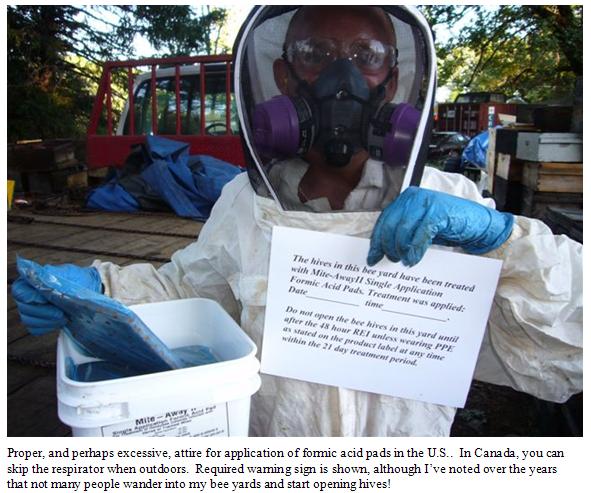
Treatment
MiteAwayII has enough market history to confirm that it can be an effective addition to the beekeepers’ arsenal. Since my experience with it is limited, I interviewed a number of researchers and commercial beekeepers who’ve used it extensively. I’ll add, though, that when I did experiment with it, what most surprised me most is that the bees appeared to totally ignore the fumes! They work apparently normally right below the pad, despite the fact that the presence of formic vapor was easily confirmed by my sophisticated analytical equipment (my nose). In strong colonies, I didn’t note brood loss, although I didn’t see fresh eggs being deposited immediately below the pads.
Effective treatment with MiteAway is very temperature and humidity dependent— outside daytime temperature highs should be between 50 and 79ºF. Too cool, and the pads don’t outgas enough to kill mites well (in fact, bees may propolize the holes shut); too hot (over 82°F), and it evaporates too quickly to give a good kill. Surprisingly, because of the formulation, the main problem in hot weather is lack of efficacy, not that it kills the bees. MiteAway is best suited for regions with moderate temperatures in spring and fall. In northern climes, there may not be a period of adequate warmth when there aren’t honey supers on the hives. In warm climates like Florida, it’s too hot all year long.
This brings us to the topic of temperature windows—the main limiting factor for formic and thymol treatments. In temperate regions, you’ll generally have two temperature windows when you can apply either product—one before the honeyflow, and one after. The shorter your summer, the more narrow your windows will be. Here’s how to figure out the windows for your area:
Go to www.wunderground.com. Enter your zip code, and hit “enter.” On the resulting page, scroll down to “History and Almanac” and click “Seasonal Weather Averages.” When the “High/Low Temperature” graph comes up, print it or enter the graph into a drawing program on your computer. Then look for the upper blue plot line (average high). This is the line you’re most concerned with, although you should allow for the violet “Record High” line, too. For thymol, draw two horizontal lines across the graph for the high and low temperature limits—one at 60°F, the other at 90°F (or a little higher for Apiguard). Then, at the two points where the 60° line crosses the blue average high line, draw vertical lines up to the 90° line—these are your earliest and latest dates for thymol to be effective. Next draw two vertical lines down from the two points where the average high line crosses above the 90° line—any dates in the middle of the graph between these lines will likely be too hot for safe treatment. You will be left with two rectangles (blue in the illustration) that are your local “thymol windows”–when it will likely be the right temperature to use the product. Do the same thing for MiteAwayII, but use horizontal lines at 50° and 79°F (pink in the illustration).
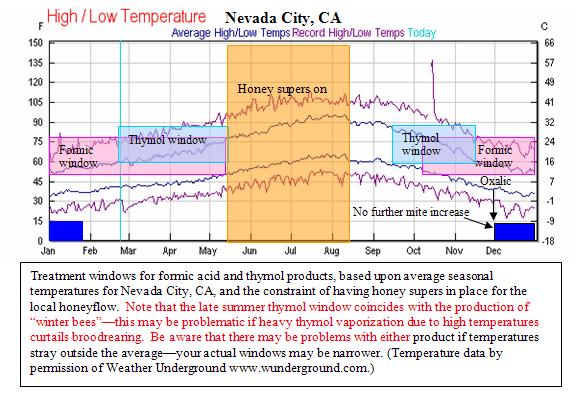
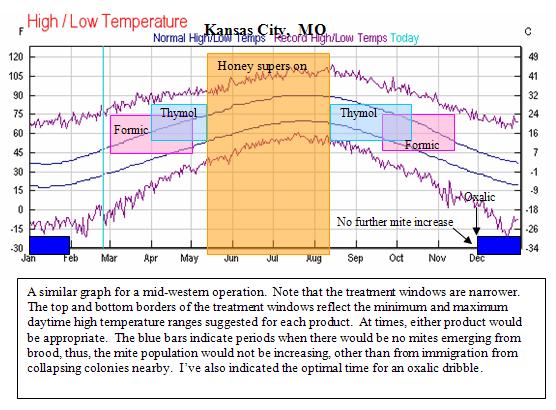
The strength of the colony is also important. Colonies weaker than six frames of bees can suffer substantial temporary brood loss, and even colony mortality, since there aren’t enough bees to adequately control the ventilation of the vapors. This does not happen in strong doubles or one and a halves. Even if brood rearing is suppressed, the colony quickly rebounds. Effective fumigation also requires tight fitting boxes and lids, but the entrance must remain wide open to allow the bees to ventilate. I’m not sure, but am assuming that screened bottoms should be blocked off.
MiteAway can be used any time that honey supers are not on (provided the temperature is appropriate). David VanderDussen recommends that it be used during spring pollination to “clean up” the colonies. He suggests that after you place the pads, you give the bees a week to adjust before you move them, and that they like to cluster in the space around the pad while being moved! Be aware, though, that formic is tough on drones. If you’re a queen breeder, springtime use of formic acid may decrease your drone population (DeGuzman, et al. 1999).
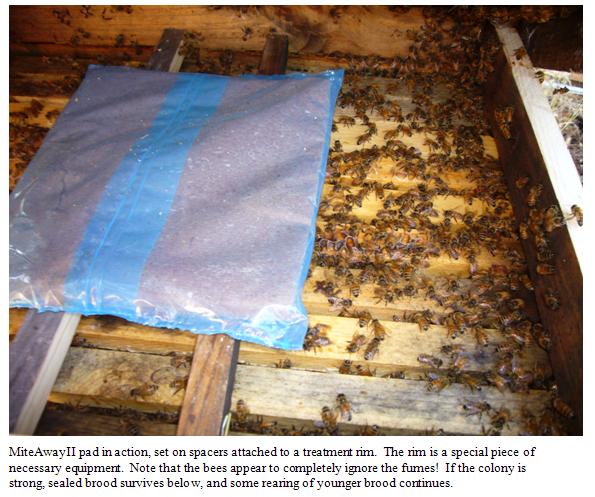
Formic can be an appropriate treatment to get mite levels down before you put your supers on for the honeyflow. If there is a band of honey across the top of the brood chamber, it acts as a buffer to protect the brood. Even an incomplete one-week “flash” treatment can kill a substantial percentage of the mite. However, if you pull the pads before three weeks are up, they will still contain formate esters, and need to be handled appropriately (and allowed to finish outgassing in a safe area). Once the pads have fully outgassed (after three weeks), they then consist of harmless cotton in a plastic wrap. You can then remove the cotton and use it for smoker fuel!
Osterman and Currie (2004) found that slow release formic boosted colony populations over the course of the season if varroa levels were above economic threshold to begin with, but suppressed colony development if mite levels were already low to begin with. Best not to treat unless sampling of mite populations warrants it.
My overall feeling from my research and respondents was that MiteAway is most effective when used as a late summer/fall treatment in temperate climes (Becker 2007, Giovenazzo 2007, Calderone 2006, Imdorf 1999, Gatien & Currie 2003). Some authors recommend an August treatment, followed by a late fall treatment when the colonies have little brood. As I mentioned before, by reducing tracheal mite as well as varroa, the bees will be in much better shape to withstand the winter. Respondents still suggest that the formic treatment be followed with an oxalic dribble when the colonies go broodless.
David VanderDussen states that most varroa IPM models are based upon a crop model of only treating when surveys demonstrate high pest levels. He suggests that we should consider basing them upon an animal husbandry model, wherein one treats twice a year on a scheduled basis (see graph). This is an attractive and simple way to plan your mite management strategy. However, at a treatment cost of several dollars per colony, making routine treatments when mite levels are naturally below the economic injury track may be a waste of your money, as well as stress your colony needlessly.
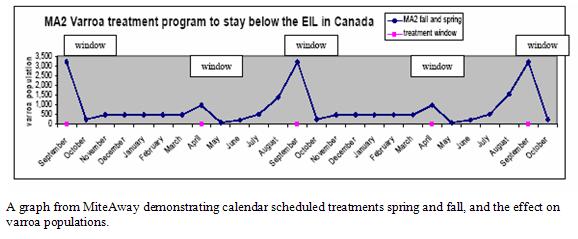
Bottom line—formic acid/MiteAwayII
Let me state that I approached formic acid with some trepidation, due to the horror stories involved with liquid formic. I was pleasantly surprised during my limited experimentation with MiteAwayII! This product resolves several safety and moderated release problems involved when using liquid formic acid. The company does most of the work for you, and it comes nearly ready to apply, although you need to supply spacer rims. With a modicum of common sense, and a pair of nitrile gloves, it can be used safely and easily.
MiteAwayII can be an effective mite treatment if appropriate treatment windows exist for your area (especially in fall), and application instructions are followed carefully. The cost is significant, but reasonable. Another advantage over liquid formic treatments is that only two trips to the apiary are required for a full three weeks of treatment—one to install, one to remove. James Bach (2006) stated that a crew of 3 or 4 persons could install MiteAway pads into 1000 colonies in 10 scattered apiaries in less than a day, and remove 1500 pads a day! Formic acid also has the selling point that there are apparently no long term residual effects from comb contamination.
References
MiteAway lid plans: http://www.miteaway.com/News/MiteAway_Migratory_Lid/miteaway_migratory_lid.php
Amrine, J.W. & Noel, R. 2006 Formic Acid Fumigation for Controlling Varroa Mites in Honey Bee Hives. Int. J. Acarol. 32:2, pp. 115-124.
Bach, J (2006) Presentation at 2006 WAS conference
Becker, B. (2007) pers. comm.
Calderone, N (2006) http://www.masterbeekeeper.org/B_files/varroa_drone_removal.htm
De Guzman, L, T Rinderer, V Lancaster, G Delatte, A Stelzer (1999) Varroa in the mating yare: III. The effects of formic acid gel formulation on drone production. ABJ 139(4): 304-307.
Donders, JNLC & ACM Cornelissen (2005) Residue determination in honey after a spring treatment with Thymovar and formic acid. Apiacta 40: 1-4.
EPA (2005) http://www.epa.gov/pesticides/biopesticides/ingredients/factsheets/factsheet_214900.htm
Gatien, P & RW Currie (2003) Timing of acaricide treatments for control of low-level populations of Varroa destructor (Acari: Varroidae) and implications for colony performance of honey bees.
Giovenazzo, Pierre (2007) pers com. Universite de Laval, Quebec
Imdorf, A, J-D Charirre, P Rosenkranz (1999) Varroa control with formic acid. In coordination in Europe of integrated control of Varroa mites in honey bee colonies. 1999 final Technical Report Appendix VI.
Keyhani, J & E Keyhani (1980) EPR study of the effect of formate on cytochrome c oxidase. Biochemical and Biophysical Research Communications 92(1): 327-333.
Milani, N (2001) Management of the resistance of varroa mites to acaracides. In Mites of the Honey Bee. Dadant and Sons
Nasr, Medhat (2007) pers comm. Crop Diversification Centre North, Alberta
Osterman, DJ and RW Currie (2004) Effects of formic acid formulations on honey bee (Hymenoptera: Apidae) colonies and influence of colony and ambient conditions on formic acid concentration in the hive. J. Econ. Ent 97(5): 1500-1508.
Liquid formic
OK, I told you that I’ve give some references for liquid formic application.
Californian Dennis Lohman (530.476.2322) sells the Formivar dispenser, which allows for all handling of the liquid in a controlled setting. It’s a nicely designed plastic bottle that fits into a wicked dispensing tray. The whole unit can be placed in the center of a medium super.
Canadian Bill Ruzicka sells MiteGone pads, and gives regular seminars in the U.S. More info at www.mitegone.com. The pads are soaked in formic acid in the field, and then pinned inside the hive.
James Amrine and Bob Noel (http://www.wvu.edu/~agexten/varroa/FAFumigat.pdf) detail use of a formic acid fumigator of their own design that is placed on top of the colony for 18-24 hours. One or two treatments per year were adequate to keep varroa levels tolerable. They suggest diluting the formic acid with the proprietary product Honey-B-Healthy (containing spearmint and lemongrass oils) to reduce queen loss. They also caution that commercial formic acid may differ from labeled concentration by up to 30%! They suggest using a hydrometer to make up FA solutions.
Canadian Jean-Pierre Chapleau (Broken Link!) (http://www.reineschapleau.wd1.net/articles/flash.en.html) has developed a bottom application of formic acid.
Many Canadians use “mite wipes”—meat tray liners with a squirt of formic. They’re cheap, but require multiple applications.
Europeans also use the Krämer plate, FAM-Liebefeld dispenser, and the Apidea dispenser.
The Mercedes of liquid formic dispensers is the Nassenhieder evaporator (http://www.nassenheider.com/english/s2.htm), developed by German Bruno Becker (http://www.nassenheider.com/pdf/nv/varroa%20en.pdf ). This device fits in a frame, and is just the kind of thing that I’d expect from a German engineer! He recommends three treatments for yearly mite control—one each in August, September, and a final cleanup in October. Mite levels are so low by then that no treatment is needed again until next August.



